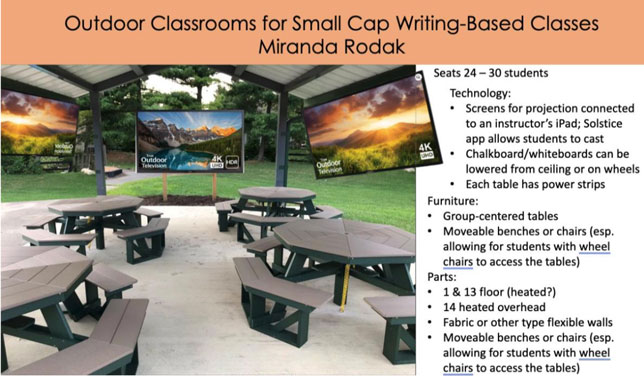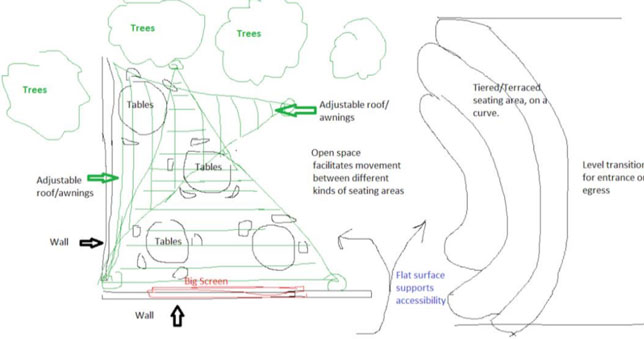Changing the Landscape: Should Higher Ed Build Classrooms Outdoors?
Outdoor spaces have been a boon to the continuity of teaching and learning during the COVID-19 pandemic, offering a solution to safety and social distancing concerns. But they also hold potential for new pedagogical approaches that can improve the student experience.
- By Tracey Birdwell, Ph.D., Tripp Harris
- 10/06/21

IUPUI faculty member Rob Elliot reimagines an already existing outdoor campus space as a classroom with a few minor additions (Image from Google Maps, 2021).
Walk around any college campus and you will find between the buildings open spaces, sidewalks and outdoor seating for studying or dining. But what if outdoor classrooms were also part of the campus landscape?
Many faculty took their classes outside last fall in response to concerns for safety from COVID-19. We recently wrote about how several higher ed institutions took different approaches to supporting teaching in outdoor locations on their campuses. From boosting WiFi access, to scheduling considerations, to building tents to protect from the weather, many campuses took similar approaches at the institutional level to quickly accommodate efforts to step outside for formal class meetings. Additionally, many faculty found their own informal ways to take class outside without broadscale support from their institutions.
What if we considered teaching outside for reasons beyond supporting emergency safety efforts or enjoying a nice day every once in a while? What if we viewed teaching outdoors as a valuable learning experience, beneficial to students' mental health and supportive of certain pedagogical approaches? What if we supported teaching outdoors through faculty support initiatives and providing venues for collaboration among instructors, administrators and technology personnel? Since early in the COVID-19 pandemic, the Mosaic Initiative at Indiana University has been exploring some of these questions.
Outdoor Design Symposium
In June, we invited a group of Indiana University faculty to our Annual Mosaic Design Symposium to consider what kinds of outdoor learning spaces they would like to use, what features these spaces would offer, where would they like them placed on campus and how teaching outdoors might influence or transform their approaches to student engagement. We gathered faculty, stakeholders from Landscape Services and the IU Capital Projects office, and architects and leadership personnel from SmithGroup via Zoom with the intent to design and share ideas about possible developments for outdoor classrooms. SmithGroup, an architecture firm, provided initial examples of outdoor classrooms. Faculty then individually designed their own spaces, focusing on their discipline-specific pedagogical approaches and locating them on their respective campuses. They also described how they would teach in these outdoor classrooms, the advantages they saw in their spaces and potential disadvantages of teaching outside.

IU-Bloomington faculty member Miranda Rodak conceptualizes a pavilion-inspired outdoor classroom on the flagship campus of Indiana University (Designed by Miranda Rodak, 2021).
For instructors, the possibilities for outdoor instruction were many, though with significant challenges. Kalani Craig, a clinical history professor in the Department of History at Indiana University – Bloomington, pointed out that outdoor instructors can even facilitate a disciplinary approach. "I can image an environmental history class could be held in a classroom outdoors," she said. "Doing so would really drive that content home. Make it more real." Andy Buchenot, associate professor of English at IUPUI, expressed concern about accessibility in outdoor spaces: "Accessibility should be at the center of all classroom designs." He stated, "When we move the classroom outside, we need to bring that focus on accessibility with us …. Outdoor learning spaces offer unique challenges to designers; uneven ground, poor acoustics and inconsistent light are all issues to consider. Designing for greater accessibility is the best way to create a space that can serve all students."
Design Symposium Outcomes
Faculty perspectives on possible outdoor designs were varied and can be found in our Symposium Summary. They were categorized into six design themes: 1) The Indoor/Outdoor Classroom; 2) Classroom as Public Art; 3) Embracing Nature; 4) Enhancing the Architecture of the Campus; 5) Outdoor Classrooms as Multiuse Spaces; and 6) Outdoor Spaces as Pavilions.

Tanya Perkins, faculty member on the IU-East campus, envisions an outdoor classroom as multi-use space (Created by Tanya Perkins, 2021).
During our discussions of the various faculty designs, Symposium participants raised a number of ideas and concerns relevant to teaching in outdoor classrooms. The following are a few highlights from the Design Symposium that were especially salient:
- Accessibility: Participants highlighted the importance of addressing the unique needs for accessibility in outdoor spaces, including sound amplification, appropriate shade and lighting, climate control, protection from allergens, wheelchair and seating accessibility, and access to essential technology.
- Location: Participants suggested that prior to building an outdoor classroom, a university might consider mapping where outdoor spaces are likely to be most successful based on WiFi availability, protections from the elements, accessibility and location.
- Scheduling: Faculty expressed considerable concern about being able to access outdoor classrooms when they needed them.
- Upkeep: Faculty were also concerned with ensuring that all technology and other tools in the space were in good working order. For example, seat and table surfaces will need to be dried after a rainstorm, as well as cleared of pollen build-up during parts of the school year.
- Visibility: For some faculty, teaching outside might offer a chance to advertise what their students do in certain courses and appeal to students still choosing a major.
- Discipline-specific learning: Faculty recognized that teaching in outdoor classrooms could be especially suitable for instruction among certain disciplines. For example, classes that require types of physical activity (e.g., woodworking, tasks involving assembling and disassembling of artifacts, etc.).
Rethinking Our Campus Spaces
A major goal of the Design Symposium was to push the boundaries of how we think about our higher ed campuses. Informal outdoor spaces are ubiquitous on college campuses and thus easier to imagine, but what if we took more campus experiences outdoors? What if we leveraged additional areas of campus for instructional purposes? What if more campus space was utilized for teaching? IU Landscape Architect Mia Williams reflected on the implications of broadening the conversation on outdoor learning space: "Why haven't we done this before? The conversation we are having now is focused on the question of: How do we leverage this whole other area of space? How do we schedule and program it in an intentional way for student learning? It's a whole new ballgame."
The Mosaic Initiative held the outdoor Design Symposium to gain faculty input at an early stage in our outdoor spaces conversation. It was valuable to garner early ideas about classrooms, and speaking with faculty has very much helped direct issues we need to consider as we continue to discuss outdoor learning spaces at Indiana University. In the coming semester, we will be speaking with students to gain their perspectives on outdoor classrooms and informal study spaces at various IU campuses.
The pandemic pushed us to rethink where we learn and how our online learning environments influence our interactions and learning success. Now that the pandemic has jumpstarted the conversation on designing formal outdoor learning spaces, perhaps more members of the higher ed community will consider how teaching and learning outdoors could fit into evolving campus learning ecosystems.
About the Authors
Tracey Birdwell, Ph.D., is program director for the Mosaic Initiative at Indiana University.
Tripp Harris is a learning sciences Ph.D. student at Indiana University.